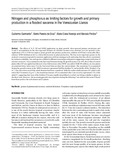Mostrar el registro sencillo del ítem
Nitrogen and phosphorus as limiting factors for growth and primary production in a flooded savanna in the Venezuelan Llanos
| dc.rights.license | http://creativecommons.org/licenses/by-nc-sa/3.0/ve/ | |
| dc.contributor.author | Sarmiento, Guillermo | |
| dc.contributor.author | Pereira da Silva, Marta | |
| dc.contributor.author | Naranjo, María Elena | |
| dc.contributor.author | Pinillos, Marcela | |
| dc.date.accessioned | 2014-11-12T16:13:28Z | |
| dc.date.available | 2006 | |
| dc.date.issued | 2006 | |
| dc.identifier.uri | http://www.saber.ula.ve/handle/123456789/39318 | |
| dc.description | Publicado en: Journal of Tropical Ecology 22 (2006). 203–212. Copyright © 2006 Cambridge University | es_VE |
| dc.description.abstract | The effects of N, P, NP and NPKS application on plant growth, above-ground primary production and N and P accumulation in the above-ground biomass of a flooded savanna were assessed over two growth cycles. Application of N or P did not improve plant growth and primary production, addition of NP had a noticeable effect, whereas NPKS fertilization led to a three-fold increase in plant production. The four most important grasses in the analysed ecosystem responded to nutrient applicationwith increasing growth, indicating that they all are constrained by nutrient availability, but each species exhibited a different seasonal growth pattern suggesting a temporal division of nutrient resources. N accumulated in the harvested biomass during the growth season was 50% above that of control plants when NP was applied and showed a four-fold increasewhen NPKS was added. With NP addition, in 2mo plants accumulated three times more P in the harvested biomass than the control plants. The maximum N accumulated during the growth season in the NPKS treatment represented half the fertilizer N, and probably all the N added (15 gm-2) may have been used if the whole biomass had been considered.With the rather small amounts of P added to the soil in the P treatment (2 g m-2), the maximum amount of P accumulated after 2mo scarcely represented 13% of the added P, suggesting that most of the fertilizer P became rapidly immobilized or sorbed, not being available to plants in the short term. However, the increasing growth rates of grasses during the following 7mo indicate that some P fluxed from these pools to the soil solution and to plants. | es_VE |
| dc.language.iso | es | es_VE |
| dc.rights | info:eu-repo/semantics/openAccess | |
| dc.subject | Grasses | es_VE |
| dc.subject | Hyperseasonal savanna | es_VE |
| dc.subject | Nutrient limitation | es_VE |
| dc.subject | P sorption | es_VE |
| dc.subject | Tropical grassland | es_VE |
| dc.title | Nitrogen and phosphorus as limiting factors for growth and primary production in a flooded savanna in the Venezuelan Llanos | es_VE |
| dc.type | info:eu-repo/semantics/article | |
| dc.description.colacion | 203–212 | es_VE |
| dc.description.email | sguille@ula.ve | es_VE |
| dc.subject.departamento | Departamento de Biología | es_VE |
| dc.subject.escuela | Escuela de Ciencias | es_VE |
| dc.subject.facultad | Facultad de Ciencias | es_VE |
| dc.subject.thematiccategory | Biología | es_VE |
| dc.subject.tipo | Artículos | es_VE |
| dc.subject.unidadinv | Instituto de Ciencias Ambientales y Ecológicas (ICAE) | es_VE |
| dc.type.media | Texto | es_VE |


